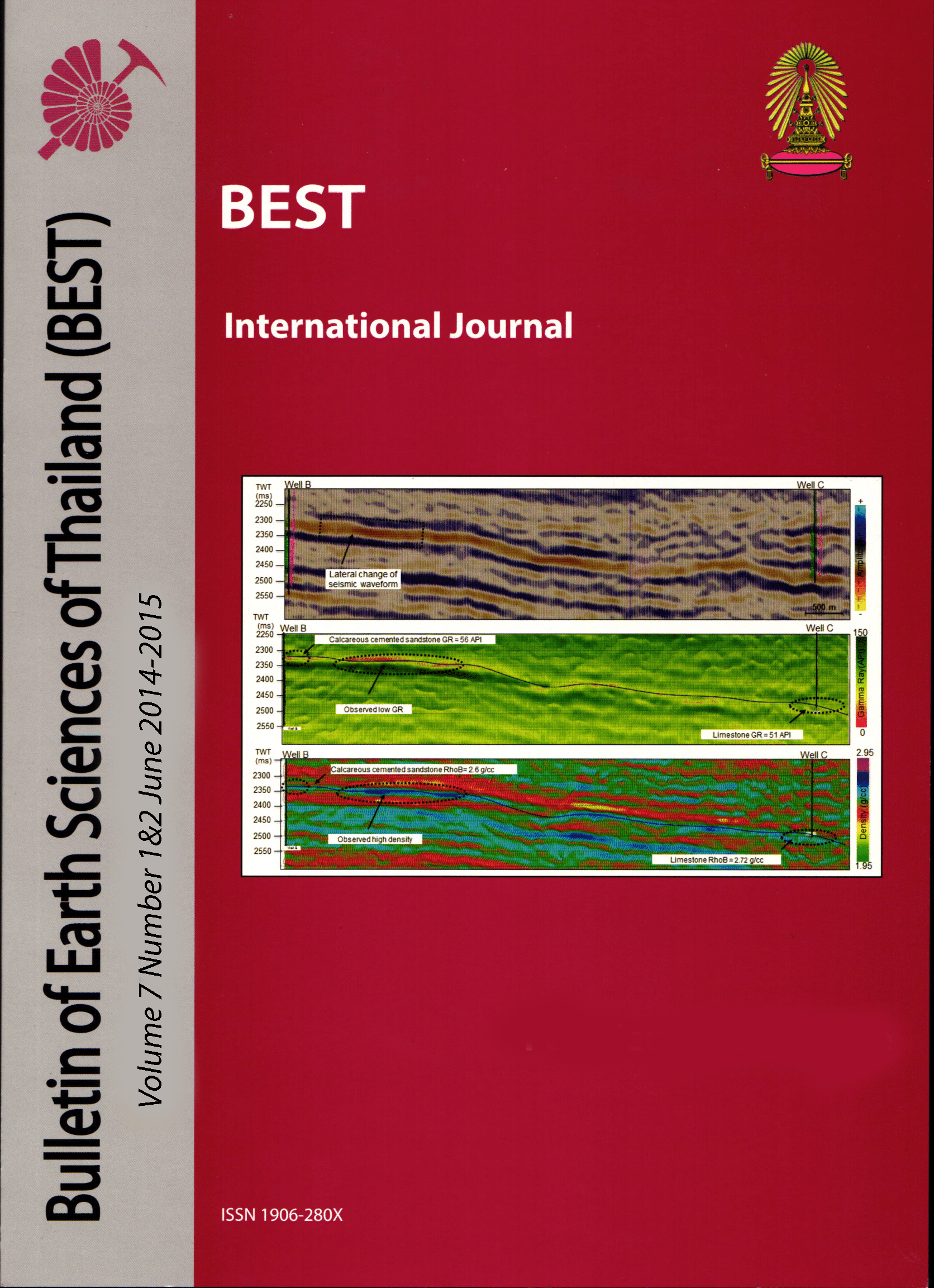Paleoenvironment study of a syn-rift stratigraphic unit in the northern Pattani Basin, Gulf of Thailand.
Main Article Content
Abstract
The Oligocene syn-rift section associated with the Similan-Lanta structural trend on the northwest flank of the Pattani Basin, Gulf of Thailand is the focus of this study. The syn-rift section hosts the main source rock in the marginal areas of the Pattani Basin and the lack of success of some wells in this area suggests an incomplete petroleum system and the general model needs to be re-evaluated. This study is primarily based on seismic facies interpretation from a 3D seismic data set and supported by well log and geochemical data. A reconstruction of the Paleoenvironment during the syn-rift was done to analyze the relationship between the underlying basement structure and the potential source rock distribution. Three main depositional facies were identified from the study including fluvial plain, lacustrine and alluvial fan facies. The seismic facies analysis suggests that the initial stage of syn-rift development created a series of isolated lakes which developed adjacent to the rift boundary fault. During the middle syn-rift stage a fluvial system developed from the north and filled up the adjacent downstream accommodation space. This was subsequently superseded by a widespread lake which developed along the basin axis in the upper middle rift stage. The structural controls which created the various lacustrine environments controlled the depth and extent of the important source rock distribution. The source rock in this area is not widespread but the geochemical analysis suggests that it is within the generating oil window and does generate hydrocarbons. Migration pathways between syn-rift source rock deposits and potential traps need to be carefully considered when evaluating this areas hydrocarbon potential.
Article Details

This work is licensed under a Creative Commons Attribution-NonCommercial-NoDerivatives 4.0 International License.
Copyright © 2008 Department of Geology, Faculty of Science, Chulalongkorn University. Parts of an article can be photocopied or reproduced without prior written permission from the author(s), but due acknowledgments should be stated or cited accordingly.
References
Aukkanit, P., 2011, Trapping Mechanisms along North Similan and Lanta Trends, Pattani Basin, Gulf of Thailand: Bulletin of Earth Sciences of Thailand, v. 4, p. 76-81.
Burton, D., and L. J. Wood, 2010, Seismic geomorphology and tectonostratigraphic fill of half grabens, West Natuna Basin, Indonesia: AAPG bulletin, v. 94, p. 1695-1712.
Carroll, A. R., and K. M. Bohacs, 1999, Stratigraphic classification of ancient lakes: Balancing tectonic and climatic controls: Geology, v. 27, p. 99-102.
Doust, H., and H. S. Sumner, 2007, Petroleum systems in rift basins–a collective approach in Southeast Asian basins: Petroleum Geoscience, v. 13, p. 127-144.
Flint, S., D. Stewart, T. Hyde, E. Gevers, O. Dubrule, and E. Van Riessen, 1988, Aspects of reservoir geology and production behavior of Sirikit oil field, Thailand: An integrated study using well and 3-D seismic data: AAPG Bulletin, v. 72, p. 1254-1269.
Ginger, D., W. Ardjakusumah, R. Hedley, and J. Pothecary, 1993, Inversion history of the West Natuna Basin: examples from the Cumi-Cumi PSC.
Jardine, E., 1997, Dual petroleum systems governing the prolific Pattani Basin, offshore Thailand.
Katz, B. J., 1991, Controls on lacustrine source rock development: a model for Indonesia.
Lambiase, J., and W. Bosworth, 1995, Structural controls on sedimentation in continental rifts: Geological Society, London, Special Publications, v. 80, p. 117-144.
Lambiase, J. J. ,1990, A model for tectonic control of lacustrine sequence in continental rift basin. Lacustrine basin exploration: Case studies and modern analogs: AAPG Memoir 50, 265-274.
Longley, I. M., R. Barraclough, M. A. Bridden, and S. Brown, 1990, Pematang lacustrine petroleum source rocks from the Malacca Strait PSC, Central Sumatra, Indonesia.
Maynard, K., P. Siregar, and L. Andria, 2002, Seismic stratigraphic interpretation of a major 3D, the Gabus sub-basin, Blocks B and Tobong, West Natuna Sea, Indonesia: getting the geology back into seismic.
Phillips, S., E. M. Laird Little, and V. Odell, 1997, Sequence stratigraphy of Tertiary petroleum systems in the West Natuna Basin, Indonesia.
Sladen, C., 1997, Exploring the lake basins of east and southeast Asia: Geological Society, London, Special Publications, v. 126, p. 49-76.


